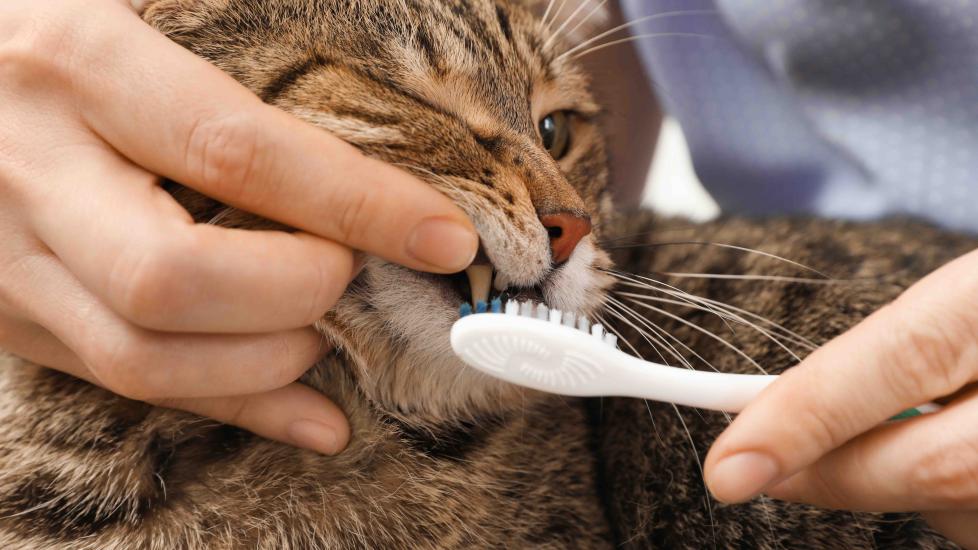How Often Should You Brush Dog Teeth and Cat Teeth?
Many of us can remember our parents telling us that we should brush our teeth twice a day and go to the dentist. We probably didn’t know it as little kids, but taking care of our oral health was an important part of taking care of our overall health.
Just like people, dogs and cats need healthy gums and teeth. Proper oral care for our pets includes brushing their teeth at home and taking them in for professional dental cleanings.
Why Brushing Dog and Cat Teeth Is Important
Poor dental care can cause many health problems. In dogs, studies show 80–90% of dogs 3 years of age and older have dental disease. Meanwhile, in cats, 50–90% of cats 4 years of age and older may suffer from dental disease.
Dental disease can lead to painful and swollen gums and tooth loss. Left untreated, severe periodontal disease can result in other health problems including kidney, liver, and heart damage because the bacteria found in the mouth can enter the bloodstream and travel to other organs.
For a complete guide to cleaning your pet's teeth, click here.
For the Spanish version, click here.
How Often Should You Brush Dog Teeth and Cat Teeth?
To prevent serious dental disease, it’s recommended to brush your pet’s teeth at home at least two to three times per week. Along with consistent at-home care, you’ll need to take your pet for a professional dental cleaning once a year.
Tips for Brushing Your Pet’s Teeth
Your pet probably isn’t going to willingly let you brush his teeth the first time you stick a toothbrush in his mouth. Follow these tips to make the process easier.
Use the Right Tools
Human toothpaste can upset a pet’s stomach—and it can even be toxic. Pet toothpaste works great for cats and dogs. Toothbrushes for pets are smaller than a human toothbrush and have softer bristles. The product you use should be approved by the Veterinary Oral Health Council (VOHC).
Because cat teeth are so small, square gauze or cotton swabs could work to brush cat teeth if you don’t have a cat toothbrush.
Begin When Your Pet Is Young
Begin acclimating your pet to tooth-brushing when they’re young. Brushing a puppy’s teeth or a kitten’s teeth helps them become used to the routine easier than starting with an adult dog or cat.
Keep Cleaning Sessions Short
Once your pet has gotten acclimated, you can move forward with actually brushing his teeth. The process for brushing cat teeth and dog teeth is largely the same.
Your pet probably won’t tolerate you cleaning his entire mouth at once. Stop every 5-10 seconds and give your pet some positive reinforcement, like petting or cheerful talking.
In total, it should take about 30 seconds to 1 minute to brush your pet’s teeth. Remember to keep the teeth-brushing session light and fun.
Teeth-Brushing Alternatives
Some pets, no matter what you do, will not let you brush their teeth. Fortunately, there are other dental care products that help keep a pet’s mouth healthy.
For example, you could try a food and water additive like the Bluestem Oral Care flavored additive. You could also try dental chews for dogs and cats. Talk to your veterinarian if you are unsure which teeth-brushing alternative to try.
Above all, do your best to make brushing your pet’s teeth an enjoyable experience, but don’t hesitate to reach out to your veterinarian if you’re having trouble with it. Remember that the better care you take of your pet’s teeth at home, the healthier your pet will be.
Featured Image: Adobe/New Africa
References
Stella JL, Bauer AE, Croney CC. A cross-sectional study to estimate prevalence of periodontal disease in a population of dogs (Canis familiaris) in commercial breeding facilities in Indiana and Illinois. Staffieri F, ed. PLOS ONE. 2018.
Periodontal disease. Cornell University College of Veterinary Medicine. Published January 3, 2023.
Feline Dental Disease. Cornell University College of Veterinary Medicine. Published October 4, 2017.
Oskarsson K, Axelsson Puurtinen L, Penell JC. Dental Problems and Prophylactic Care in Cats—Knowledge and Perceptions among Swedish Cat Owners and Communication by Veterinary Care Staff. Animals. 2021
